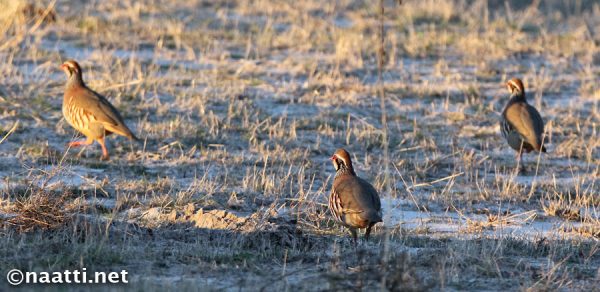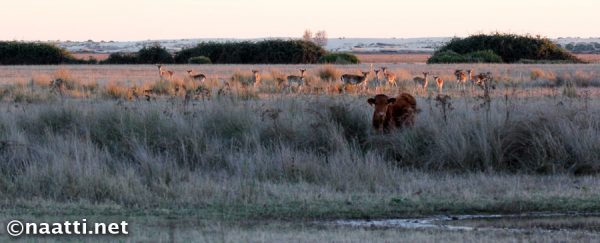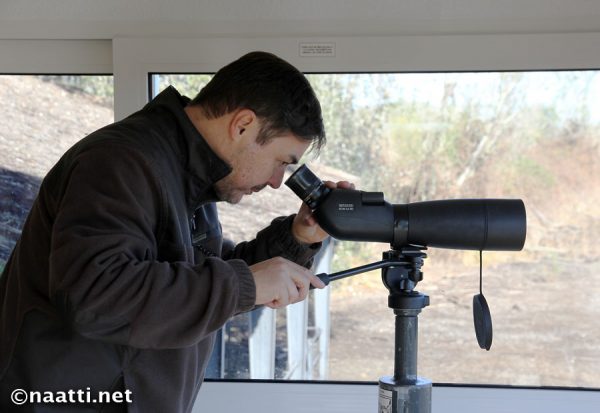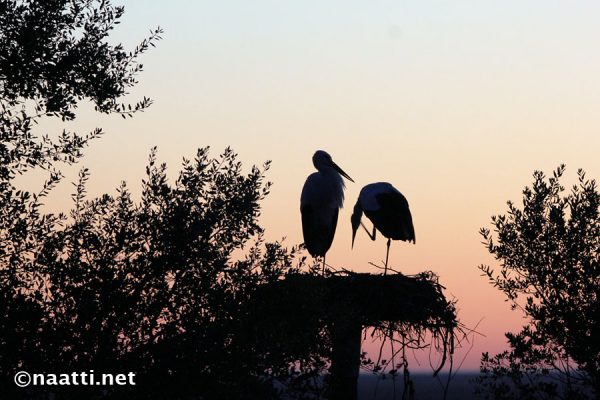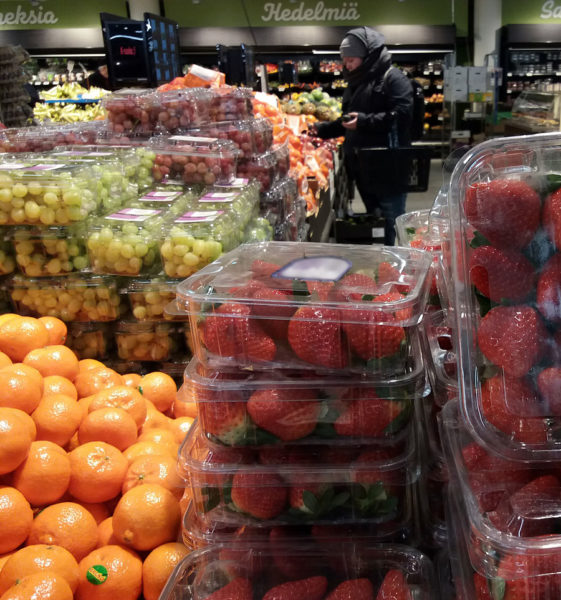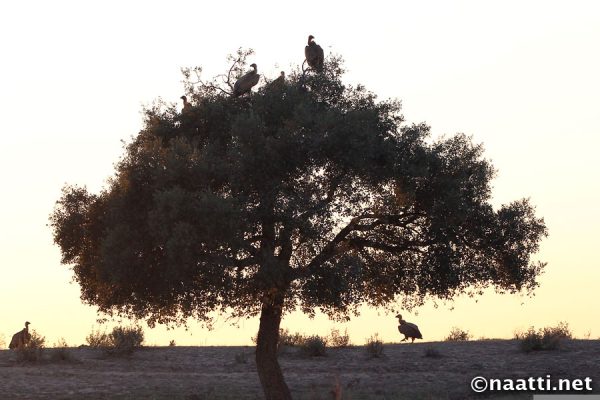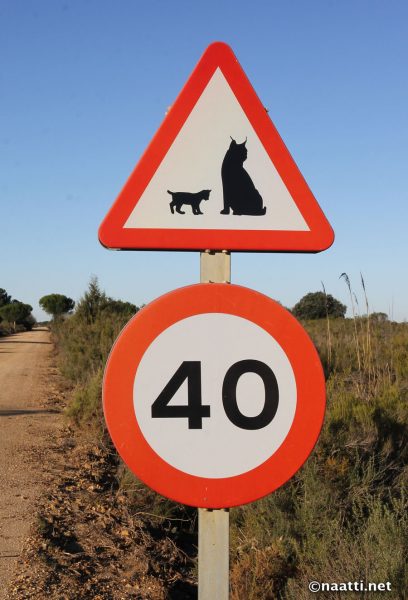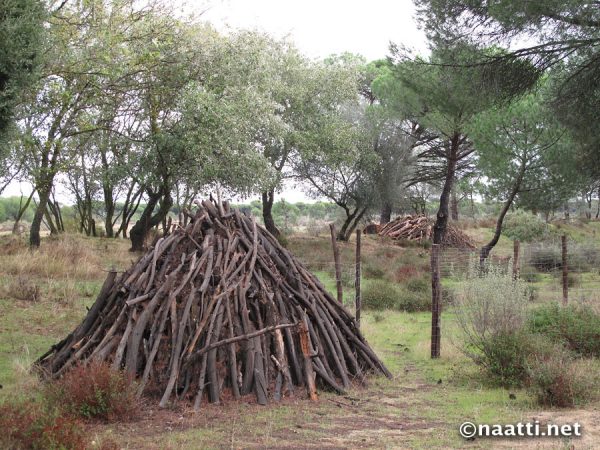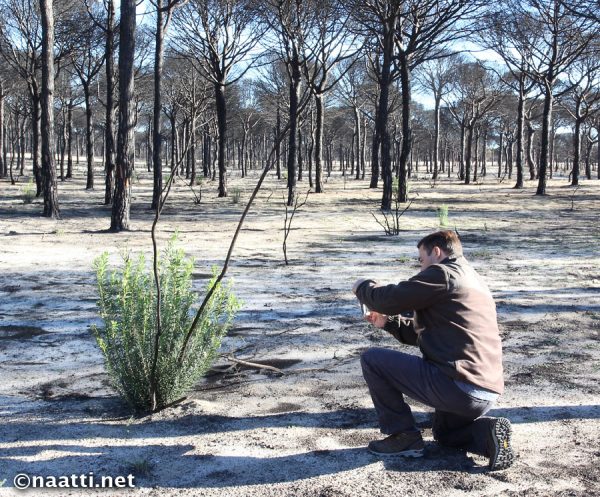(Part of this article is published in Finnish with different illustration in WWF-lehti 2/2019.)
The Doñana wetland surprises a trodder of the Finnish marshlands with its extent and versatility. Small ponds, cork oak groves, muddy surfaces and open scrubland as far as you can see. – Not to speak about the moving sand dunes, from which one can peer at the waves of the Atlantic.
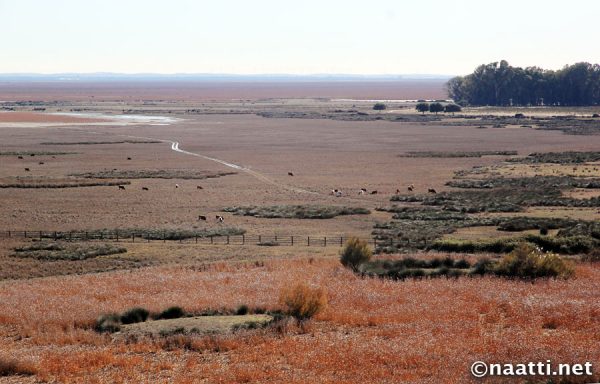
The Doñana wetland dries out in the summer. Towards late fall the ponds begin to fill again and vast areas are inundated. The hills of the Cádiz area loom in the horizon.
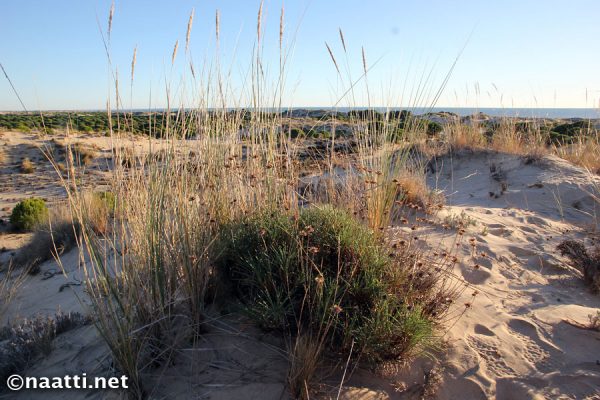
Wind moves the moving dunes grain by grain towards inland like a slow wave. Low vegetation grows on the slopes of the dune, and when the dune over time slows down, juniper and pine take over.
This diversity and the location between Europe and Africa has made Doñana a bird paradise for millions of migrating and nesting birds, and also to nature enthusiasts and tourists following them. These marsh expanses with their surroundings also support some extremely endangered species, like the Iberian lynx and the Imperial eagle, the two being emblems of Doñana.
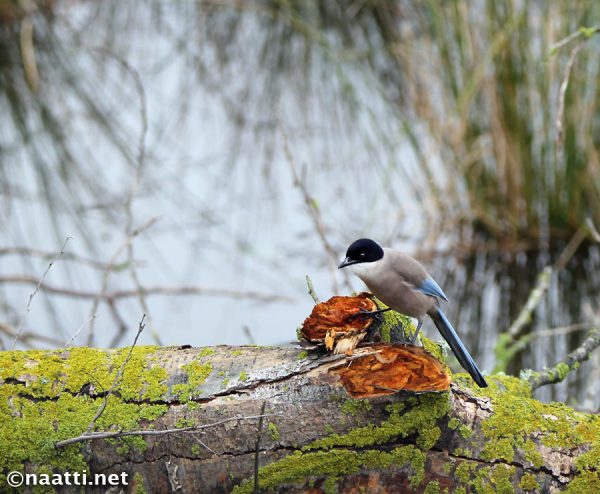
It is easy to observe birds from the many bird hides along Doñana´s nature trails. For example azure-winged magpie nests and winters here.
Doñana belongs to the international Ramsar convention on wetlands, to the EU:s Natura network and to the Unesco World heritage sites. The nucleus of the area has been created to a national park by common effort of WWF and the government, and it is surrounded by a more loosely regulated nature park.
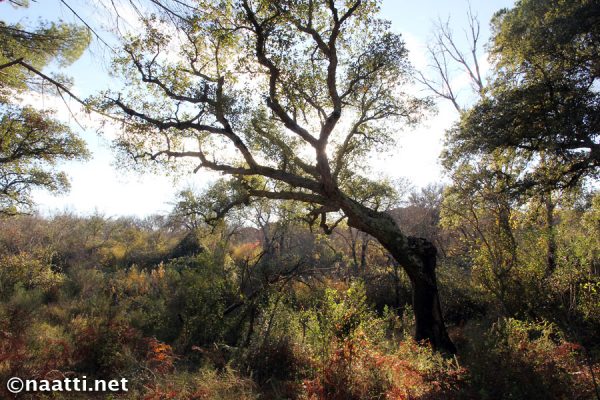
Cork oaks are specially protected in Doñana, because many species need them for shelter or food. For example grey herons, cattle egrets and common spoonbills build nesting colonies in old cork oaks, which are called the aviaries of Doñana.
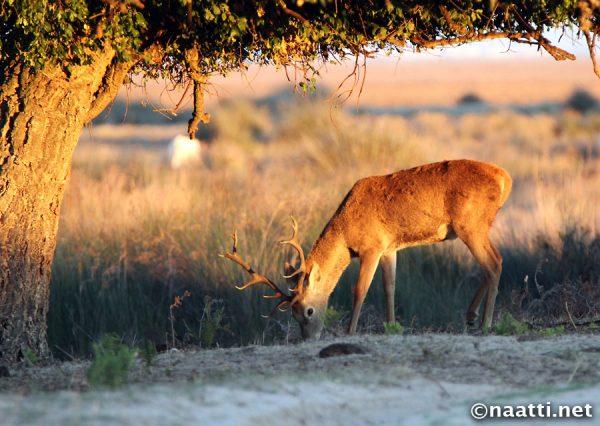
Red deer are common in Doñana. They favour acorns, of which they compete with wild boars. Their autumnal heat ”berrea” with the fights and bellows of stags is a popular nature event.
Nature conservation began
WWF expert Felipe Fuentelsaz knows the area well. He works for the Doñana office of WWF and is in charge of water, agriculture and food production issues.
AK: Felipe Fuentelsaz, how would you describe the role of WWF in protecting Doñana?
– WWF was born in the 1960’s, and its history is closely linked with Doñana. A group of European naturalists created a fund (World Wildlife Fund, WWF), to slow down the distruction of many natural areas in the world. One of its first actions was the purchase of almost 7000 hectares of wetlands in Doñana, which were under the threat of being dried.
– They saw in Doñana a unique place in the migration of birds from northern Europe, since every year we receive more than six million migratory birds.
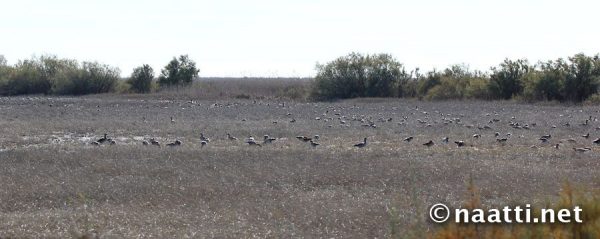
According to the Finnish Bird ringing centre lots of Finnish nesting birds winter in Doñana: common buzzards, European kestrels, greylag geese, common cranes, redshanks, song thrushes, robins and others. A flock of greylag geese pictured in the marsh.
The disappearing waters
AK: There are lots of pressures towards the nature of Doñana. Which ones do you regard as most important?
– During the latest 30 years Doñana has lost about 50 % of the water that it gets through rivers and streams. The global climate change has its effect, but the great concern and the main threat is the theft of water with illegal wells.
– There are more than 2000 illegal hectares of strawberries and other berries that take water from wells without permits, causing less water to reach the marshes of the Doñana National Park, Fuentelsaz explains.
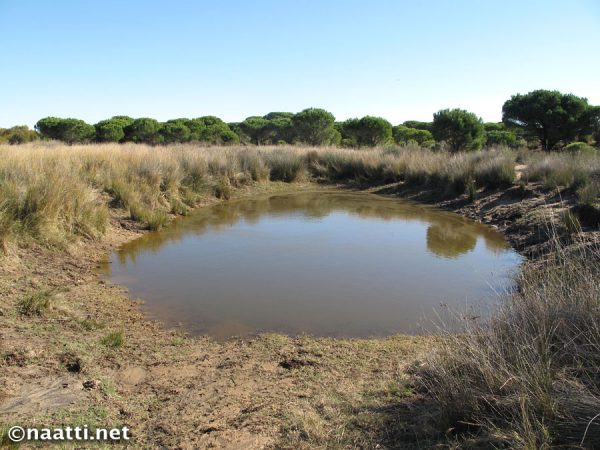
A water hole for cattle. The ranchers have dug and deepened such holes, when the groundwater has dwindled. These are the last stronghold for many aquatic species. However, they are also contact points between cattle and wild boars, facilitating the spread of tuberculosis. Biologists develope solutions for the cattle and the boars to drink from different spots, to prevent such contact.
Market chains involved in conservation
– WWF works with companies and farmers to find solutions. In recent years we have collaborated with English, Swiss and German supermarkets to ensure within their purchase criteria the legal use of water and soil in strawberry crops in Doñana, and to help farmers improve their environmental practices in farms, says Felipe Fuentelsaz.
– Thanks to the campaign many big food companies and market chains in Europe began promoting more sustainable strawberry production, for example Migros, Tesco, M&S, Innocent Drinks and EDEKA.
Regards to Northern market chains and tourists
Felipe Fuentelsaz encourages also Northern market chains to join in the strawberry campaign:
We encourage Nordic supermarkets to analyze the situation of their farmers in the area, supporting legal farmers and guaranteeing that the products they provide to their consumers respect the Doñana National Park.
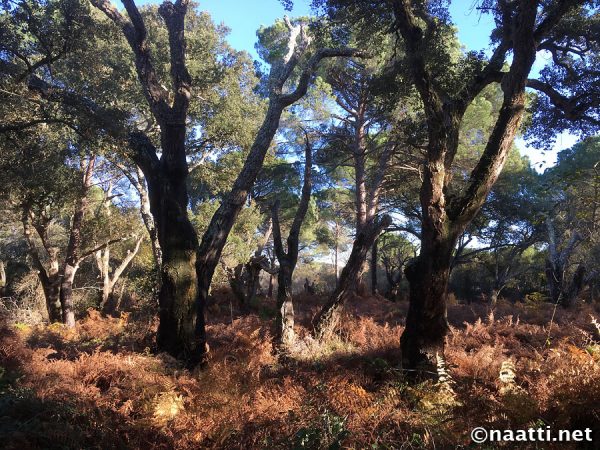
A charming nature trail starts from the Acebrón visitor centre and leads through cork oak groves along La Rocina river.
Tips for Finnish tourists
Fuentelsaz has also tips for Finnish tourists, who visit Southern Spain:
– The culture of environmental protection of Nordic countries is always welcome in Spain. They are standard bearers of protection and can teach Spanish citizens a lot.
– In Andalucia there are lots of natural spaces to explore and many nature tourism companies. Doñana offers fantastic visits to its marshes, forests, beaches and dunes. Those who know Costa del Sol can be amazed by the beaches and dunes of Doñana, since we have 30 kilometres of continuous virgin beaches without any houses or hotels, only sea, waves and dunes, and many seabirds.
– In our marshes we welcome geese, cranes and many other species that come from Northern Europe, and we are obliged to take care of them so that they return home healthy.
Wetland created by the sea and rivers
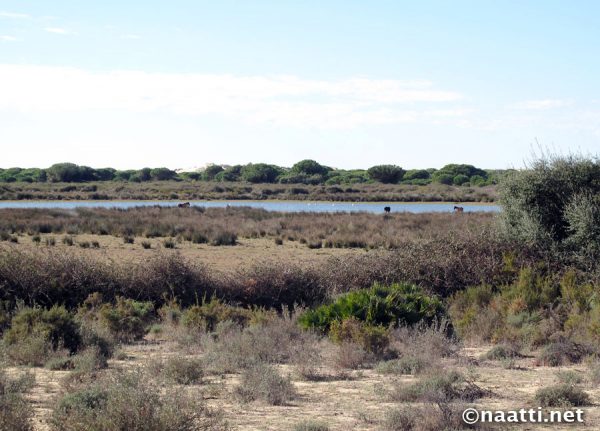
Doñana is a mixture of many nature types. Behind the sand dunes there is a partly salty lake, where flamingos and other birds feed. Dry Mediterranean scrubs, junipers and stone pines grow around it.
The wetland was once created by the Andalucian main stream Guadalquivir with its many tributaries. The main branch is still a wide river, along which ocean ships sail to the inland port of Sevilla.
The mighty wetland grew on the low-lying coast, when the coastal sand dunes dammed waters coming from Guadalquivir. The wetland nowadays gets approximately half of its waters from rain and the other half from rivers.
Waters govern all life of the wetland: the surface waters and the subterranean waters, their quantity and their purity. Part of the year many sections of the wetland and lots of ponds are dry. Some of them are saltier, some are sweeter, and the percentages vary according to the rains. Some rivers and ponds have grown solid and turned into permanent scrubland.
Many rivers have been dammed for agricultural purposes, and especially in the Eastern part of the area large rice fields, fish ponds and salt pools have been founded. A couple of tributaries in the national park have been restored later, and parts of the dried areas have thus returned to their natural state.
Researching the vast marshland
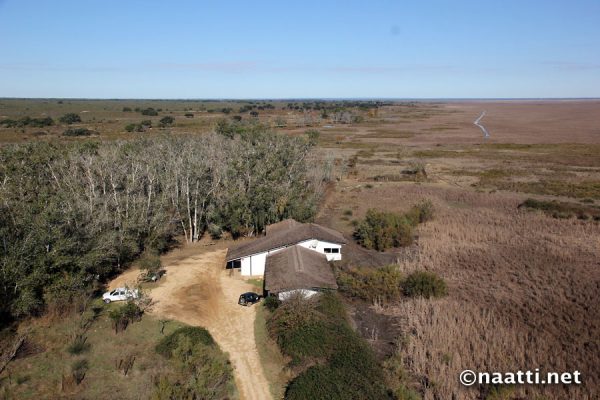
The Doñana Biological Reserve, the field station of Doñana’s Biological Station, is located in the most strictly protected area on the verge of the vast marshland.
Luis Santamaría is devoted to the study of nature in Doñana. He leads the Doñana biological station´s long-term monitoring programs, which reveal the changes in the wetland nature. He also researches wetland ecology and plant-animal interactions.
The programs monitor the area´s fauna, flora, water quality and circulation, and carbon sequestration. The longest lasting monitorings have been the bird counts, which have been done ever since 1975. This is a demanding task, because the visiting birds are counted in hundreds of thousands yearly.
– We train new counters by spreading a large quantity of beans on the table, and with the help of the beans they learn to estimate quantities quickly. Birds have to be counted from huge flocks in units of hundreds or thousands, Luis Santamaría explains.
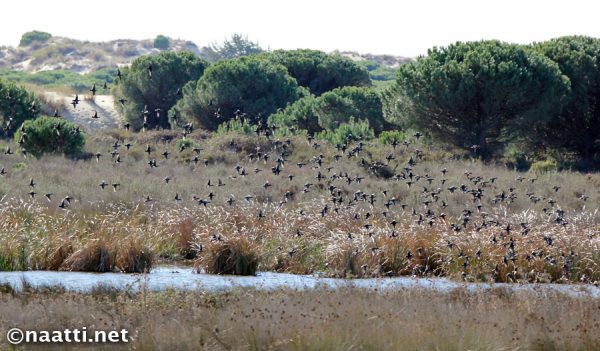
Thousands of birds arrive from North Europe to Doñana to winter, the greatest amounts being of greylag goose, common teal and northern shoveler. A flock of teals on a pond behind the dunes.
The trails of lynx, fox, mongoose, wild boar and genet are counted from fire alleys opened to the sand. Butterflies and other insects are counted by walking fixed routes. Passerine birds are monitored using oint and transect counts.
Monitoring nature with horses and drones
Aerial censuses are complemented by on-the-ground observations for colonial, rare or difficult-to-identify species. Across the marshes, the counts have to be done from horseback. For this the biological station uses retuerta horses, an indigenous breed adapted to walking in the marsh. The station carries the main responsibility for protecting this breed.
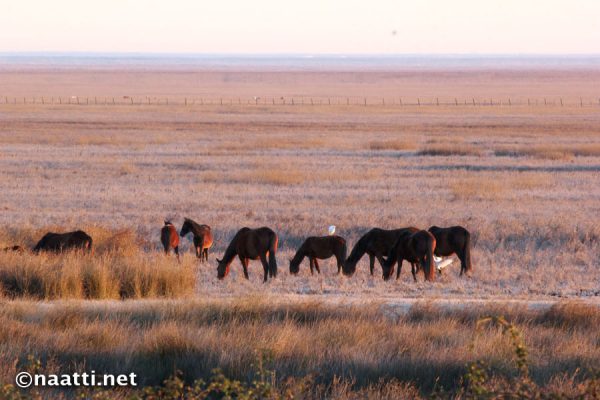
Horses grazing on the marsh belong to the indigenous breed of retuerta horses. The aim is to reduce the amount of cattle and to increase the portion of autoctonous breeds.
– We are continously incorporating the use of new technologies – such as the use of high-resolution images acquired with drones for colonial bird count, the use of images acquired with drones and satellites to monitor for example the state of the cattle pastures and the growth of the juniper woods, or the use of automated phenocams to monitor vegetation phenology. These data are always compared with ground-truth, field data, for validation, Luis Santamaría tells.
Rich species variety helps endure changes
In addition to monitoring, the biological station has many tasks in international, basic and applied research. One of its departments focuses its research on the ecology and conservation of wetland species.
The station supports many species conservation projects, for instance for ibises, Iberian lynx, bee eaters and giant bats. Amongst the vegetation, cork oak woods are of special conservation concern, because oak is home to a great variety of species but its reproduction is severely limited by overgrazing and groundwater depletion.
Adapting business with nature
The biological station also aims at producing knowledge and information, which helps the versatile economic activities in the area to better adapt to the accelerated changes caused by man to nature. – These kind of improvements progress slowly, but progress has been made, says Luis Santamaría.
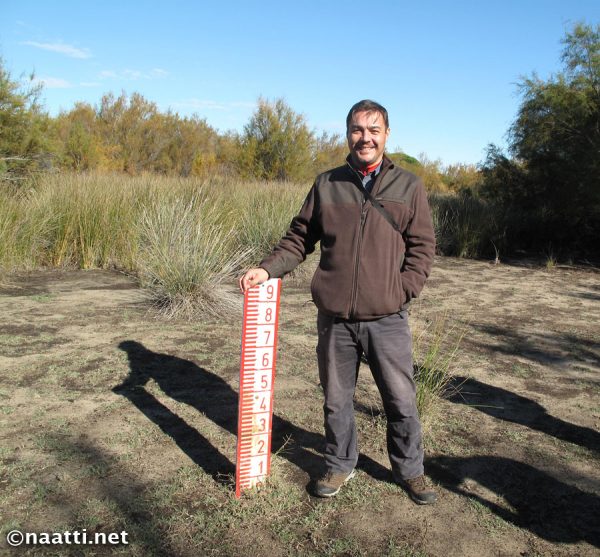
Luis Santamaría presents a lake he has monitored for years. It has gradually dried and changed into tamarisk bushland, which tolerates ephemeral inundation and salty groundwater. There are dozens of lakes like this in Doñana.
Santamaría agrees with WWF’s concerns about the impact of certain activities, notably water extraction for strawberry crops, on the national park’s ecosystems. He notes, however, that some producers have made a considerable effort in reducing water and pesticides use – so regulation should ensure that illegal farmers do not stain the effort of those working towards sustainability. A similar dynamic, with regulation-based improvements that could improve with better enforcement, takes place in the nearby rice fields.
Thousands of hectares of marsh, which were formerly used for livestock ranching, have been changed under government rule into natural food ponds producing fish and crustaceans. The waters in the ponds are regulated so that flora and micro-organisms thrive and produce food for fish and thousands of waterbirds.
The majority of a large estate, Veta la Palma, which had been turned into agricultural polders in the 1960’s, was restored into natural fooding ponds and marshland. The estate became one of the most outstanding birding spots in the Doñana area, where thousands of waterbirds, waders and pink flamingos feed.
Also consumer choices can protect the wetland
The first strawberries in the spring come to Finland from Spain and especially from Doñana. When buying them you can send a wish via the shopkeeper, that the market chain clarify the production site of the strawberries and find more information from WWF.
For cooking rice porridge you can buy organic rice produced in the Doñana region. Rice is usually regarded as a bad choice for climate, but European organic rice is clearly an above average alternative environmentally.
The rice plantations in Spain and Italy apply organic methods and strive towards sensible use of pesticides. EU has forbidden some harmful chemicals that are still used in Asia. Also rice produced in EU has travelled from a moderate distance – from as far as many of our migratory birds.
Facts about Doñana:
Location: On the Atlantic coast in Andalucia, Southern Spain, in the provinces of Huelva, Sevilla and Cádiz
Area: appr. 1200 km2, almost half of which is national park and the rest is nature park
Altitude from sea level: 0–40 m
Species: appr. 1300 plant species, 170 of which endemic. Appr. 2000 animal species.
Inhabitants in the region: appr. 200 000
Main industries: agriculture and tourism
Medium temperatures: 4,6ºC– 32,6ºC (January–July)
Year of the mighty wetland
The life of the wetland is based on the yearly rhythm of the waters. Part of the year many areas of the wetland are dry. The rains and everything that happens in the drainage basin of the rivers have an effect on the life of the wetland.
Major yearly events in Doñana
(source: José Antonio Valverde visitor centre)
September: Heat of the red deer
October: Heat of the fallow deer
November: First geese arrive
December: Water rises on the marshland
January: Marsh changes into sea
February: Sun heats the water
March: Sedges and bullrush sprouts
April: The sea becomes green
May: Marshes are full of life
June: Water levels drop
July: Temporary ponds dry out
August: Soil cracks of drought
The rare Iberian lynxes only number a couple of hundred in the world. Their numbers in Doñana were reduced considerably after a virus disease cut down the amount of their most important prey, the European rabbit. Now there is an attempt to increase their numbers, for example by building wood heaps to shelter the rabbits.
To visit Doñana
The Doñana nature area is situated on the Atlantic coast in Southern Spain near the city of Sevilla and the border of Portugal. It consists of a national park and a nature park, which surrounds it from different sides.
The national park (parque nacional) is mostly closed to the public. Only conservation officers, researchers, authorized nature guides with their customers, and guardians of a couple of traditional livestock estates are permitted to move there.
The nature park (parque natural) contains a multitude of industries, villages, plantations and tourism. It forms a protective zone around the strictly protected national park. It has beautiful nature spots for locals and tourists to enjoy, to have picnics and to admire nature.
Interesting villages
There are some interesting villages around the national park:
– Matalascañas: a beach resort, popular in the summer and ghostly quiet in the winter
– El Rocío: a Wild West style pilgrimage destination with unpaved roads for the pilgrims to come with their horses
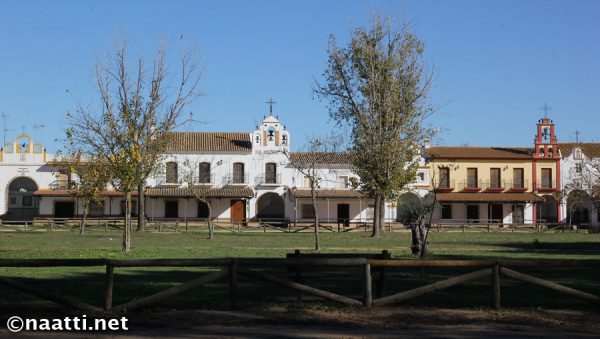
The village of El Rocío is like from Wild West. The roads are unpaved because of pilgrims´ horses, and the house fronts have wooden posts instead of parking lots. There are even restaurants, where one can eat or drink from horseback.
– Isla Mayor: a village of rice farmers in the middle of vast marshlands.
Visitor centres
The best way to get to know the nature of Doñana is via the visitor centres of the park and the Birdlife birding centre. For example:
– Acebuche visitor centre: Nature exhibition, trails of 1,5 and 3,5 km, many bird hides. Wetland quite dry during the dry season. Three kilometres from the Matalascañas tourist village.
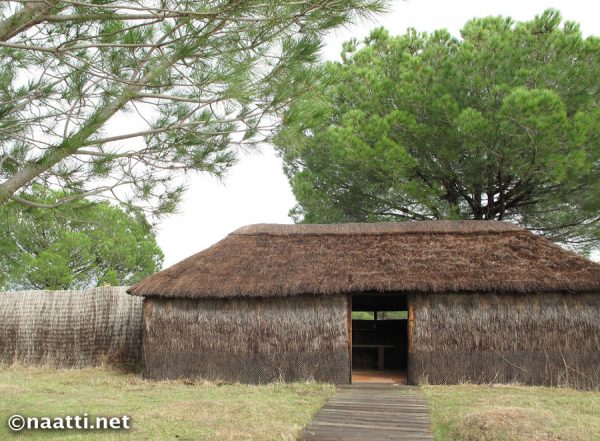
The nature trails at the Acebuche visitor centre circle around many ponds. It is easy to observe the wetlands´ dwellers from the bird hides.
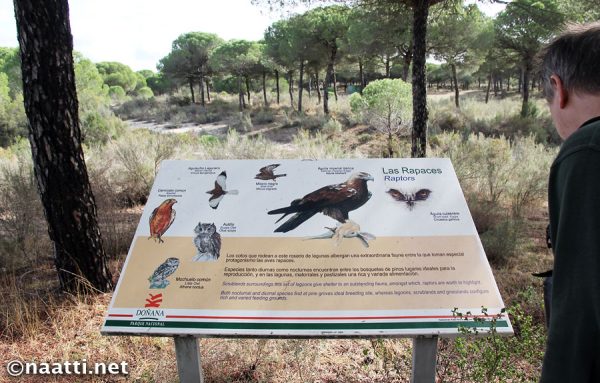
Birds of prey can be frequently seen in Doñana. They catch their prey from forests, scrublands, lagoons and grass areas. Information board from the nature trail of Acebuche visitor centre.
– Acebrón visitor centre: Ethnographic exhibition in a grand palace. Nature school and nature trail of a couple of kilometres in the surroundings of La Rocina river. Lush and versatile wetland and cork oak groves. About seven kilometres from the village of El Rocío.
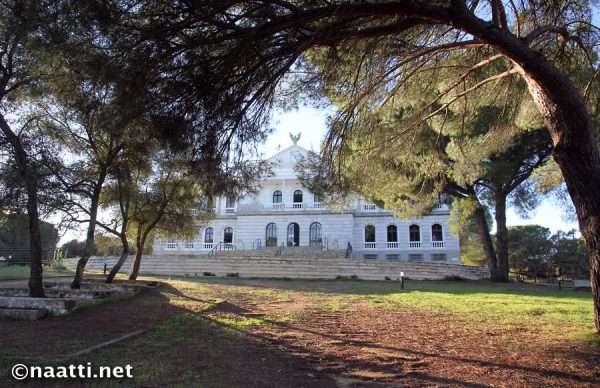
The handsome Acebrón palace was built in the 1960´s as a private residence and a hunting lodge. Now it is one of the visitor centres of the national park and tells about the history and ancient means of living in the area.
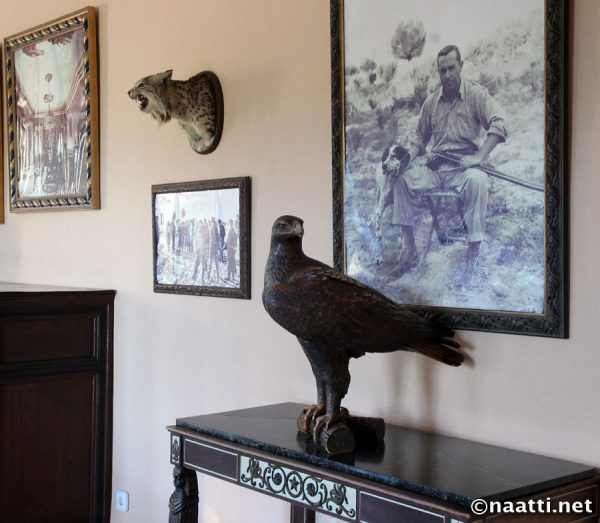
Iberian lynx and Iberian imperial eagle, nowadays endangered and protected animals, were once desired hunting preys. Photo from the museum in the Acebrón visitor centre.
– La Rocina visitor centre: Diverse nature trail on the riverside of La Rocina river. Information about the pilgrimage of El Rocío. About one kilometre from the village.
– José Antonio Valverde visitor centre (named according to one of the founders of the park): Great birding place by a restored wetland in the middle of vast marshland. 25 kilometres by unasphalted road from the village of Isla Mayor. It is recommended to check the condition of the road in advance.

A huge amount of birds of prey live in the scrublands, for example Iberian imperial eagles, common buzzards and short-toed snake eagles. Common buzzards compete of the control of fence posts on the way through the marshland to the José Antonio Valverde visitor centre.
– Fabrica de Hielo visitor centre: Exhibition of the flora and fauna of the area, also cultural history. Situated in the city of Sanlúcar de Barrameda by the delta of the river Guadalquivir.
– Birding centre of SEO Birdlife: Great birding place, information in many languages, checklist of the 300 bird species that can be observed. In the village of El Rocío by the lake Charco de la Boca.
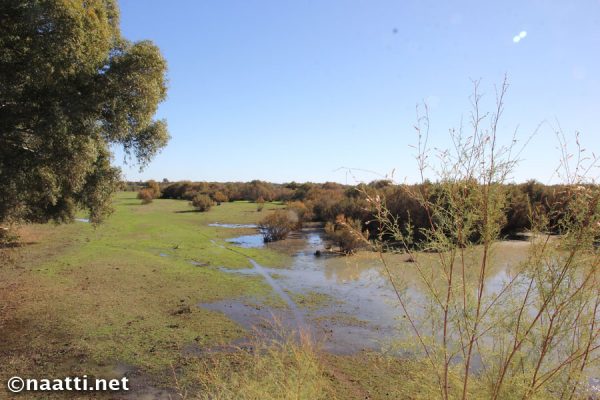
The majority of the water maintaining the wetland flows nowadays via the small Rocina river from the direction of the pilgrimage village El Rocío. A permanent lake Charco de la Boca has been formed in front of the village. Photo taken from the visitor centre and bird watching site.
There are also other nature trails and bikeways in the nature park. The coastal dunes are free for walking even in the area of the national park from Matalascañas towards southeast, provided you keep within 100 metres from the coastline.
Authorized companies arrange trips to the national park all year round. You can choose a trip by foot, bike, horse or jeep. The trips have to be booked in advance, because the amount of visitors is limited. The Andalucian government recommends visiting Doñana in fall or winter, when there is no rush, the temperature is pleasant and the observation of wintering birds is easy.
Burned forest
In the dry summer of 2017 there was a threatening forest fire in the vicinity of the Doñana national park. The fire spread rapidly among the stone pine plantations and burned 9000 hectares. The pines were once planted to produce pine nuts, and the dense uniform pine forest was easily flammable. Biologists now monitor the development of the burned area and recommend sparser forests with more species variety.
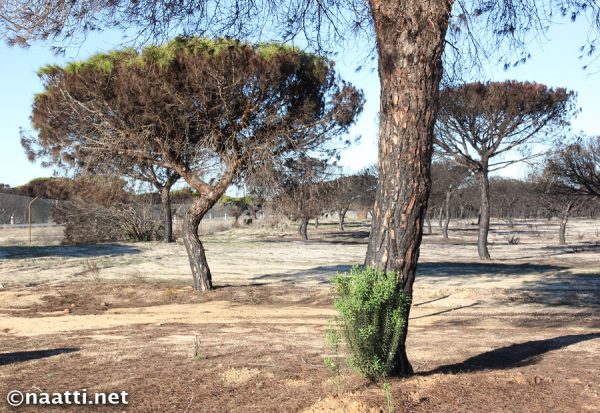
The burned stone pines are still partly green and may survive the forest fire. Also many herbs and bushes sprout from their old roots: for example local junipers and daphnes, aromatic herbs by the roadsides like thyme, rosemary and lavender, and also the non-native acacia (below).
More about Doñana in English:
Ecologists Defend the Invaluable Doñana Wetland – 2018
In Finnish:
Doñana osa I – Meren ja jokien rakentama luontoparatiisi – 2019
Doñana osa II – Mansikat uhkaavat maailmanperintökohdetta – 2019
- The Invaluable Doñana Wetland Facing Threat of Drought – 2019
- Neonicotinoids – Even PPBs Are Too Much for Insects – 2019
- Ecologists Defend the Invaluable Doñana Wetland – 2018
- European Mink Returns to Estonia – 2016
- Diving for Marine Protected Areas – 2015
- Organic Gardening Inspires Youngsters in Northern Spain – 2015
- Plastic Debris Spoils the Oceans – 2015
- Only Cute and Cuddly Are Worth Conserving? – 2014
- Gilbert´s Potoroo Was Rescued on an Australian Island – 2014

